#Cosmar
Explore tagged Tumblr posts
Text
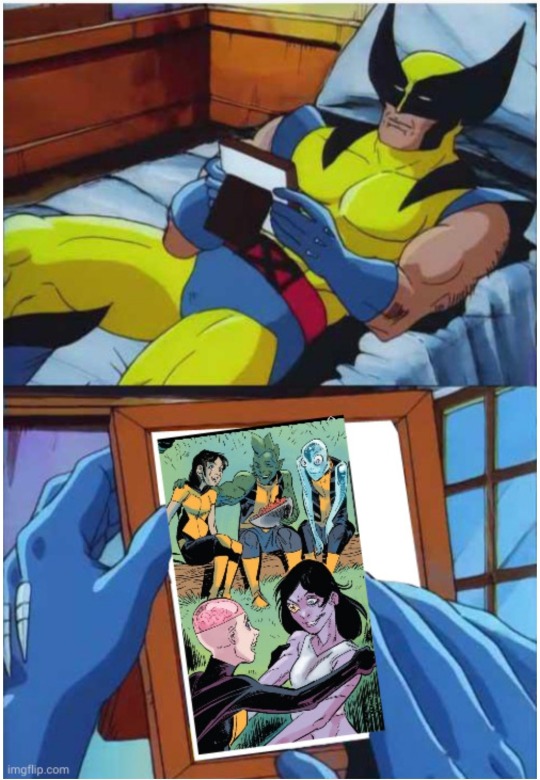
Me wondering when we'll see the Lost Club again.
#lost club#marvel#gabby kinney#honey badger#martha johansson#cerebella#natashia repina#cosmar#carl aalston#rain boy#victor borkowski#anole#meme#emarma's
23 notes
·
View notes
Text

Natashia Repina aka Cosmar — commission
#natashia repina#cosmar#fanart#my art#digital art#artists on tumblr#digital artist#small artist#digital painting#art#artwork#marvel#marvel comics
13 notes
·
View notes
Text

• favorite female centric comic/movie/episode/storyline/etc
the art is not comprehensive of her whole lil arc but I really enjoyed Cosmar’s introduction into the comics! Her & Martha’s struggles with older mutants on feeling comfortable in their bodies & w/ their identities felt very relevant and delightfully handled
#xwomenaw23#xmenuniverse#natashia repina#cosmar#cosmar xmen#new mutants#x men#I drew this almost entirely during the first act of damn Yankees because it’s so fucking long#this is entirely ink pen and drawn on a notepad standing up#at work with minimal referencing possible
17 notes
·
View notes
Text
The Hole


Contestants Index
#tournament of x#the hole bracket#round 1#half 1#cosmar#natashia repina#genesis#x men#marvel comics#krakoa#x men comics#xmen#tournament#poll tournament#tournament poll#bracket#tumblr tournament#character tournament#tumblr bracket#tumblr polls#poll
11 notes
·
View notes
Text
Never forget how short Gabby is compared to the rest of the Lost Club... Cause I never even noticed till now

#marvel#marvel comics#x men#x men comics#new mutants#new mutants volume 4#gabby kinney#carl aalston#vic borkowski#tashi repina#martha johansson#honey badger#scout#rain boy#anole#cosmar#cerebella#no girl#she tiny no matter what age she is
19 notes
·
View notes
Photo

Oh my god. Anole’s face in particular is just... I don’t know.
#Magik#Illyana Rasputin#illyana rasputina#Marvel#new mutants#James Proudstar#Warpath#dani moonstar#rahne sinclair#Wolfsbane#xi'an coy manh#gabby kinney#gabrielle kinney#Cosmar#victor borkowski#Natashia Repina#carl aalston#Rain boy#Cerebella#martha johansson#Marvel Comics
16 notes
·
View notes
Text
VACANȚĂ DE COȘMAR ÎN GRECIA- ROMÂNI INSELATI DE CONDIȚIILE INSALUBRE ALE CAZĂRII
VACANȚĂ DE COȘMAR ÎN GRECIA- ROMÂNI INSELATI DE CONDIȚIILE INSALUBRE ALE CAZĂRII Un grup de români, format din șase adulți și opt minori, ce sperau să petreacă o vacanță de vis pe insula Thassos au avut parte de o vacanță de coșmar. Cazarea fusese rezervată și plătită integral încă din luna ianuarie prin platforma Booking.com, la Beachfront Apartament Thassos. Însă, când au ajuns la destinație,…
0 notes
Text
New Mutants (2019) (the comic book, not the movie) is honestly excellent at handling this. Starting from Issue #14 onward, the comic explores being a mutant as a metaphor for disability. All of the characters in the book are also disabled, which definitely helps. I would really recommend checking it out! Anyone who's reading this can feel free to DM me for a link to a comic piracy website.
Spoilers under the Read More.
Some background information, you can skip if you're familiar with X-Men comics from the past 20 years.
This takes place during the Krokoa era, which began in 2019, where mutants have founded their own ethnostate, Krokoa. The ethnostate bit is mostly done in other books during the era, and a switch in editorial direction halfway through means that it is not handled super great. The important thing is that everyone is immortal now (through cloning and digitalized back ups of brains), and mutant powers are venerated.
In 2005, House of M happened, which resulted in 99.9% of all mutants losing their powers. In Krokoa, they have invented a way to reverse this: ritual combat to the death. You fight a death match, you lose and die, and then you get brought back to life in a new clone body that has your powers. This is called Crucible, and it's considered a staple of Krokoan culture. It's kind of a trans allegory, but it's also handled pretty messily at times.
That's the end of the background information.
So, a new character is introduced, named Cosmar. Her mutation is a kind of reality warping, and her fear of herself and her destructive powers caused her to transform herself visually into a monster. She wants go through Crucible, so that she can get her old body back. She asks her mentor, Dani Moonstar, Mirage, to be her partner in Crucible, so she can die and get her old body back.

Dani refuses, saying that the purpose of the Crucible is to heal the mutants who have lost their powers, and as Cosmar still has her powers, she's perfect and doesn't need to change.

Cosmar runs off, and Anole, another mutant who's powers have physically mutated him, stops Dani from chasing after her.
This scene is pretty obviously a metaphor for disability. Cosmar's mutation has disfigured her, and she wants a cure. Dani, who used to hate her own powers (making everyone experience their worst fear), tries to console her, but her words are empty platitudes. Dani's speech feels the same as any other well meaning speech "never say can't" speech given to disabled people. It's the same speech Storm gives Rogue!
As the comic continues, different mutants with different disabilities have different ideas about how they want to proceed with their powers and disability, and come into conflict with each other about it. When Karma goes through Crucible, she chooses to keep her prosthetic leg. Martha, who has no body and is just a brain in a jar, chooses to get herself a new body, but elects for her new body to have a transparent skull, as she feels it best reflects herself. It turns out that Crucible is unable to give Cosmar her old body back, as her powers will keep reverting her back to her current state, but she's able to get the mutant equivalent of cosmetic surgery/physical therapy to help get her to a place where she's more comfortable.
This comic puts in a lot of work exploring how and why characters would have different perspectives on their disability/mutation, and doesn't try to present a single "correct" answer as to what disabled people/mutants should feel. I've often felt the mutant metaphor was honestly dead at this point in time, as you can now just make comics about whatever minority group mutants were supposed to be a stand-in for. New Mutants (2019) managed to solidly convince me otherwise!
maybe there is a smart piece of xmen media that handles this gracefully but whenever i encounter something from that setting i think about that post where storm lectures rogue about how their powers are a gift when storm can control the weather and rogue hurts everyone she touches
it also just fundamentally does not work very well as a metaphor for discrimination
246 notes
·
View notes
Text

Did this on a whim. This is Cosmar, Cosmo Lord. (Cosmar belongs to @sentinelguardian)
20 notes
·
View notes
Text
Natashia Repina headcanons

She speaks with a Ukrainian accent
She calls Gabby "Gabrielle" and rolls the 'r'
She danced ballet as a child and wants to dance again
Her favorite color is red
She has a crush on Gabby
Dani is her legal guardian
She's a quiet person except around her friends
Tea over coffee
She's blind in her yellow eye
Her favorite animal is a butterfly
She collects pretty rocks
Her mother taught her how to play piano
#i have a fic about her coming out in feb. :)#marvel#natashia repina#tashi repina#cosmar#lost club#new mutants#headcanons#emarma's
8 notes
·
View notes
Text

[ID: a page full of sketches of various character and monster designs. End ID]
Some monsters redesign concepts
#The Pinewood Theater#Cosmare#Blake#Nat#other characters that dont have decided names#on the fridge#character corral#art#oc#sketch
1 note
·
View note
Text
Iesiti la vot. Va rog eu. Iesiti la vot. Nu cred ca multa lume se simte in locul meu, dar... Chiar daca am avut oarecum parinti iubitori de mica, ei tot m-au abuzat enorm. E ciudat ca tendintele lor abuzive si faptul ca nu pot gandi rational la unele lucruri e in tandem cu optiunile lor de vot. Poate nu va puteti convinge familiie. Eu stiu ca sunt in aceasta situatie. Am incercat anul trecut, am incercat acum, dar sunt spalati pe creier. Abuzul inca continua, pentru ca daca ar fi sa nu zambesc si sa zic ca trec peste, pentru ca depind de ei financiar, ei mi-ar face viata un cosmar. Asa ca nu insist in ai convinge. Sper ca cineva din cei care cititi, daca ati fost in ceva similar, sa nu va simti-ti la fel de vinovati cum ma simt eu. Scuze daca am facut greseli gramaticale, nu sunt intr-o stare buna.
18 notes
·
View notes
Text
Ugh, there are so many good characters that we only got glimpses of in the Krakoan era but that's more than we'd gotten in YEARS, not to mention new characters.....I could make entire books and lineups just of new and old-but-obscure characters who got focus but not enough focus in the Krakoan era, and I'm afraid of them vanishing into obscurity again....
Tag, Specter, Feint, Jon Ironfire, Alchemist, Wiz Kid, Cosmar, Manifold, Tempo, Theia, Galura, Tran Cao Manh, Tulkas, Firestar (we actually got Justice in ONE X-story FINALLY but it was only an Unlimited issue *sob*), Trinary, Kylun, White Sword, Khora of the Burning Heart, Sunfire, Lactuca, Christian Frost, Lourdes Chantel, Bei the Blood Moon, Flourish/Creep, Nekra, Third Eye, Somnus, Eye-Boy, Frenzy, Thunderbird, Aura Charles, Isca the Unbeaten, Solem, like LITERALLY SO MANY.....
And I'd be massively surprised if we got more than Firestar, Frenzy and Thunderbird in any projects going forward, sigh.
At least a few people like Synch, Destiny, Kwannon, Greycrow and Escapade got lasting focus and raised profiles out of it. But there was room for so many more and now despite having like fourteen titles already announced in the new era, other than those named we're back to the basics with a mere smattering of potential appearances for non big name mutants here and there.
Like the X-Factor preview pages already pretty much give away that Rusty's about to die again after only JUST being brought back in one small side story after three decades dead. What is even the point of that? What a fucking waste.
10 notes
·
View notes
Text
The Hole
Announcement!
Welcome to the Hole Bracket! From the beginning, the Tournament of X has been a double-elimination tournament, so now that the primary bracket has concluded, it's on to our unfortunate losers' second chance. Whosoever wins the Hole Bracket will escape the Hole and be granted a shot at winning the entire Tournament of X!
With that said, the First Half of Round One will begin in five days on Saturday, September 2nd, at 8AM EST! The First Half of Round One will consist of 32 matches, and each matchup will be open to voting for one week.
The lineup for the First Half of Round One is as follows:
Match 1: Fenris vs. Christian Frost
Match 2: Lactuca the Knower vs. Ora Serrata
Match 3: Lost vs. Caliban
Match 4: Abigail Brand vs. Malice
Match 5: Nameless, the Shape-Shifter Queen vs. Mondo
Match 6: Burke vs. Amass
Match 7: Wagnerine vs. Fabian Cortez
Match 8: Crule vs. Spike
Match 9: Cam Long vs. Sprite
Match 10: Doorman vs. Darkstar
Match 11: Icarus vs. Broo
Match 12: Cipher vs. Mimic
Match 13: DJ vs. Silver Samurai
Match 14: Orphan-Maker vs. Asp
Match 15: Mesmero vs. Solem
Match 16: Oya vs. Dragoness
Match 17: Sevyr Blackmore vs. Wither
Match 18: Syzya of the Smoke vs. Tarn the Uncaring
Match 19: Cosmar vs. Genesis
Match 20: Typhoid Mary vs. Mentallo
Match 21: Whirlwind vs. Summoner
Match 22: Arclight vs. Blink
Match 23: Professor X vs. Maggie Braddock
Match 24: Candra vs. Havok
Match 25: Snot vs. Mad Jim Jaspers
Match 26: Jumbo Carnation vs. Big Bertha
Match 27: Redroot the Forest vs. Pestilence
Match 28: Rasputin IV vs. Empath
Match 29: Jersey Devil vs. Toad
Match 30: Alchemist vs. Proteus
Match 31: Fever Pitch vs. Neal Shaara
Match 32: Mr. Immortal vs. Wallflower
Remember, this tournament is a contest of popularity, not a contest of abilities. As always, asks and propaganda are both welcomed and encouraged.
Contestants Index
#tournament of x#the hole bracket#round 1#half 1#x men#marvel comics#krakoa#x men comics#xmen#tournament#poll tournament#tournament poll#bracket#tumblr tournament#character tournament#tumblr bracket#tumblr polls#poll
58 notes
·
View notes
Text
New Mutants vol. 4 #18 – Homecoming
The imperative of a mutant community
Vita Ayala (Writer), Rod Reis (Artist), Travis Lanham (Letterer)
Let’s begin with first principles.
The two foundational, definitional characteristics of the New Mutants are the closeness of their bonds, lines between platonic and romantic almost permanently blurred, and their trauma, both individual and shared. The New Mutants’ mission on Krakoa, explored so beautifully in this issue, is to foster a community strong enough that it can guide and support each of its individuals to unburden themselves of the trauma of the past and flourish in the future.
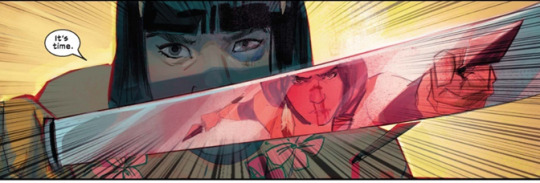
The New Mutants begin their utopian journey in this fashion by creating a support system for younger mutants, no longer constrained by human frameworks and ideologies. This is symbolised by their new home the Sextant, which is itself a metaphor for charting a new course towards a future with limitless possibilities. When Vita Ayala takes over writing responsibilities from Jonathan Hickman from issue 13, they more closely interrogate how this idealism plays out in practice. As the shadow of the past begins to encroach on the Akademos Habitat in the form of Amahl Farouk, the young students are attracted to the allure of easy solutions to their problems. The teachers also perceive Krakoa as an opportunity to release the trauma they’ve held onto for many years but know that this victory must be hard fought. Enter Dani Moonstar aka Mirage to guide them through.
After Magik becomes a War Captain and de facto combat leader of the team, Dani remains the team’s spiritual and emotional leader, as well as the lead educator for the Lost Club, the island’s youngest mutants. While Mirage doesn’t have a story dedicated to her throughout the run, she remains active rather than passive, supporting the team through the period of introspection and reflection that the safety of Krakoa has afforded them.
Ayala uses Mirage to great effect throughout their run, using her innate skill of empathy to de-emphasis the distinction between individual and shared trauma. Ayala’s approach to this feels so realistic, as Dani does not always get this right, avoiding a trap that writers fall into with the character being so morally upstanding that her judgement is beyond reproach. While issue #18 is a wonderful testament to Dani’s strength as a leader and the nature of her bond with Karma, there’s only so much that a community leader can do for her people without wider structural support. Wolfsbane and Cosmar are examples of attentions become spread too thinly, which is a catalyst for calamity and guilt that later issues must resolve. All of Dani’s attention is on Karma’s battle to reclaim her identity by separating her from her ‘evil’ brother Tran, who she has stored in her soul for almost her entire life to protect the world around her. In a society that promises amnesty and support for its former villains, New Mutants #18 examines the precarious moral balance of self-actualisation and community protection through one of the Krakoa era’s most controversial plot devices: the Crucible.
The healing rock
The issue begins with Karma and Mirage sat on a rock by a waterfall, hands held in meditation as Dani facilitates a conversation between Xuân and Tran on the astral plane. This is the same rock that Karma finds Wolfsbane sat on in the opening scene to issue 1 and offers her guidance about capitalising on the potential of her rebirth and finding new purpose. It is a space that symbolises the spiritual connections between the team, and the importance of quiet introspection as a way of resolving problems and challenges. It’s representative of Ayala’s approach to the series, which is to buck the superhero comic trend and resolve issues through philosophical debate rather than physical conflict. That’s not to say that action isn’t core to this issue because it is, but the resolution to the problem is arrived at here on this rock which then plays out in the crucible itself.
Rod Reis’ use of pastel tones and inking to differentiate between the corporal and astral figures and between past and present tense is both economical and visually stunning. The washed out tone clearly demarcates the past tense, while the flare ups of Karma’s pink power signature emphasises Karma’s intense frustration and despair at the lack of success of previous attempts to separate her from her brother. Floating ink lines resembling restraints circle Tran’s body loosely throughout the scene, suggesting Xuân’s reluctance to incarcerate him. At the scene’s conclusion, the inks have become thinner, symbolising the loosening of the bonds and his imminent freedom.
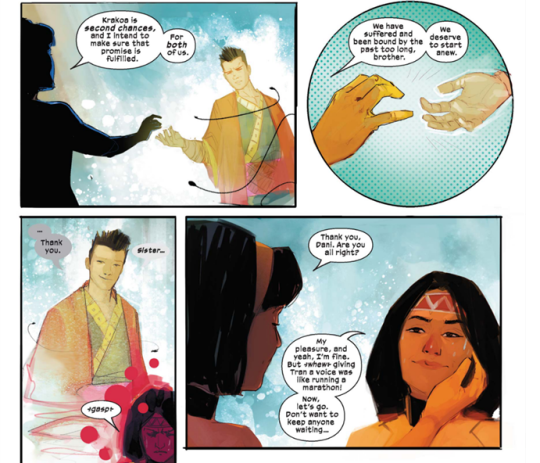
“Tôi đã có bạn - I’ve Got You”
So why is the ritual of the Crucible so crucial to Karma’s story? First of all, it demands conviction. It demands that Xuân reckon with the conundrum of whether her full spiritual independence is worth the risk her brother poses to the community around her. And yes, it demands brutality because the foundational principle of the Crucible is rooted in violence, the premise that paradise should never come easily, even to those who deserve it, because it is simply worth so much.
In the Crucible scenes, Ayala and Reis combine to great effect to simultaneously create a violent intensity and gentle intimacy to the fight. The pacing ebbs and flows as Xuân’s creeping doubts are answered with Dani’s violence before the scene breaks away for Karma to “waver here, in this moment between breathes” as her memories of Tran as an innocent child and as a damaged man as the narrative caption boxes pose the question “who is Tran?”. The fluid, sketched panelling gives way to thick bordering on the bottom panel of the page as the reader sees Karma, sword in hand, resolved in her decision: ultimately, it is not for her to choose. Tran must be given the grace to find his own path.
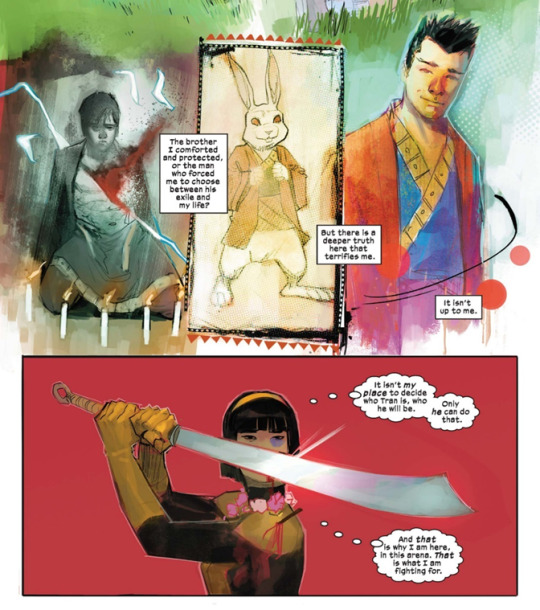
The scene then ramps up to a frenetic yet almost silent crescendo as Dani stabs her with an arrow. Throughout this scene, when the narrative is from the two central figures’ perspectives, the background is dark pink, symbolising Karma’s internality, while everyone else is faded out. It’s just the two of them together, dancing to a song of violence written with pure love. The issue’s closing scene is a moving testament to the love between them, with Karma flirting with Dani as they stare into each other’s eyes in a way that brings us back to first principles: friendship and romance are fluid among the New Mutants, but what is clear is their deep affection for one another.
Other than the potential romantic elements, Ayala’s decision to have Dani be Xuân’s partner is a smart one in that Dani is probably the most self-actualised of the New Mutants. In the original New Mutants series, she was the first to lose her powers, the first to succumb to her trauma in the form of the Demon Bear and therefore the first to be saved by the found family around her. The passing on of care from one community to member to another is contrasted in later issues where the New Mutants talk to the Shadow King about breaking the cycle of trauma and replacing it with something more productive. By separating herself from the pain of her past, symbolised by the influence of her brother, she finally has complete autonomy: freedom to be who she wants but also to pay the kindness forward to others, which she is able to do with Cosmar in a later issue.
So when Karma is resurrected with her prosthetic leg still in place, accompanied by the narrative caption box of “Welcome Home”, the message is loud and clear: mutant paradise is being the version of yourself that you most love and identify with, and the Crucible is the hard road to travel to get there.
The Lost Club
What is striking on a re-read is how much of this issue is dedicated to the Lost Club and the debate between Gabby Kinney and Cosmar about the efficacy of the Shadow King’s promise to restore the mutants to their idealised self. The scenes are very dialogue heavy, which weigh down the issue slightly, but they are important and completely on theme.
The Lost Club, and Cosmar in particular, present an alternative viewpoint on the theme of self-acceptance. If Karma’s decision to resurrect herself with her prosthesis still in place is a strong message of rejecting disability as something to be fixed, Cosmar’s experience is perhaps an allegory for body dysmorphia or more specifically gender dysphoria. The pop philosophy of self-acceptance generally argues that a person should accept themselves for who they are, which implies a rigidity of identity shaped by a patriarchal view of gender. The point that the children with visible mutations like Cosmar, Anole and Rain Boy make to Gabby is that what if what you see in the mirror prevents you from expressing who you are? How can one accept a version of oneself that is false?
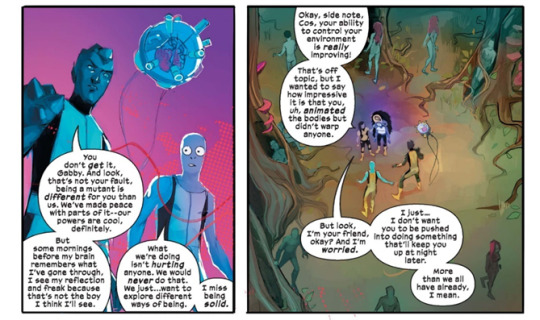
Ayala is challenging a generally held belief in X-Men continuity, perpetuated by the Krakoa era, that possessing a mutant power is necessarily a gift. In the past this notion has generally been challenged by mutants whose powers are destructive, like Rogue or an even more extreme case like Glow Worm, but this comic explicitly is not interested in that. This is about the person behind the powers, and not just whether or not they look “different” from others. This comic is interrogating ways in which people look different from how they perceive themselves, and in that way is an interesting examination of body dysmorphia at the very least.
So while the Crucible scene is a beautiful example of how a community can support the individual, the Lost Club plot is about what happens when a community fails its citizens. The Shadow King, although characterised fairly sympathetically in this run, represents the systems that exploit those left vulnerable by lack of community care. Without spoiling what happens in future issues the seeds of this plot’s central argument are laid here: while they don’t always get it right, the New Mutants have their fellow citizens best interests at heart, and are a positive example of an inclusive and accepting community.
However, the point made by Magik in her letter to the Quiet Council gets to the root of the issue: local communities need the support of central government to best serve its citizens. In an economic and political climate in which vital funding and protective legislation for communities and their vulnerable citizens are being gutted to fund genocide and war, the idealism of Krakoa was always fated to be just another utopia.
10 notes
·
View notes